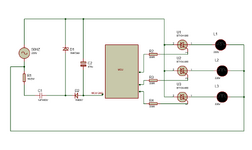Mithun_K_Das
Advanced Member level 3

- Joined
- Apr 24, 2010
- Messages
- 899
- Helped
- 24
- Reputation
- 48
- Reaction score
- 26
- Trophy points
- 1,318
- Location
- Dhaka, Bangladesh, Bangladesh
- Activity points
- 8,254
There are different types of Transformerless power supply designs. Most easy and common one we use in small designs is:

Besides this design, we also use this design,

These circuits are very simple and have the minimum components. But the problem is, the zener diode frequently gets burnt and if the voltage variation is over 20V, then output goes low in case of low input and in case of high input, the zener becomes hot, and at a time it gets burnt.
To prevent this, usually, a transistor is usually used with zener and resistors. But in that case, the output voltage drops as well as cost & component increases.
There are ICs like Viper12A/22A but those also increase component number as well as cost. In this situation, what else can be done so that the zener lasts longer and also the circuit's overall cost does not increase significantly?
Note that the load we are driving with this power supply is an MCU, an IR sensor, and some TRIACs. Overall max consumption is 100mA @5V
Besides this design, we also use this design,
These circuits are very simple and have the minimum components. But the problem is, the zener diode frequently gets burnt and if the voltage variation is over 20V, then output goes low in case of low input and in case of high input, the zener becomes hot, and at a time it gets burnt.
To prevent this, usually, a transistor is usually used with zener and resistors. But in that case, the output voltage drops as well as cost & component increases.
There are ICs like Viper12A/22A but those also increase component number as well as cost. In this situation, what else can be done so that the zener lasts longer and also the circuit's overall cost does not increase significantly?
--- Updated ---
Note that the load we are driving with this power supply is an MCU, an IR sensor, and some TRIACs. Overall max consumption is 100mA @5V



